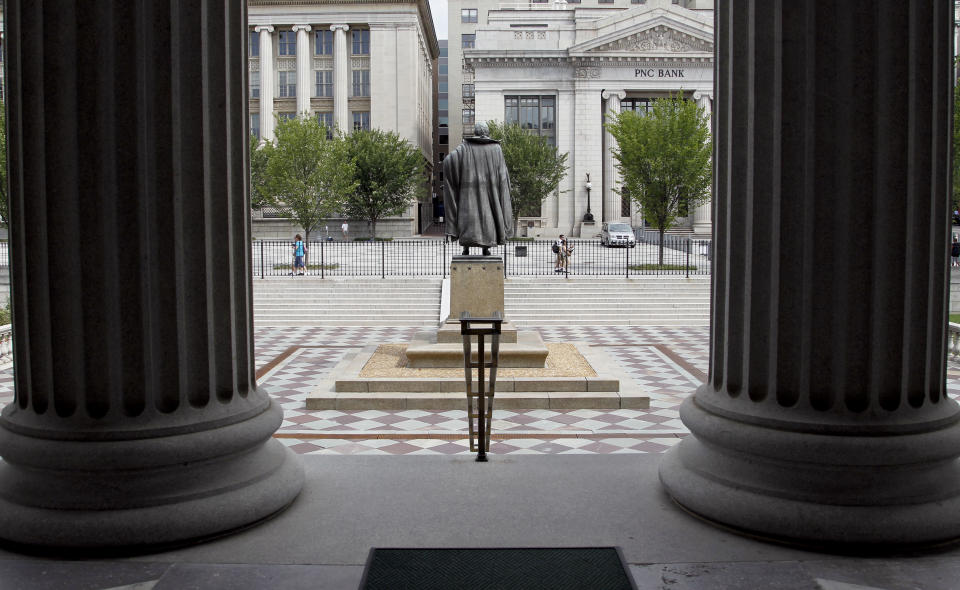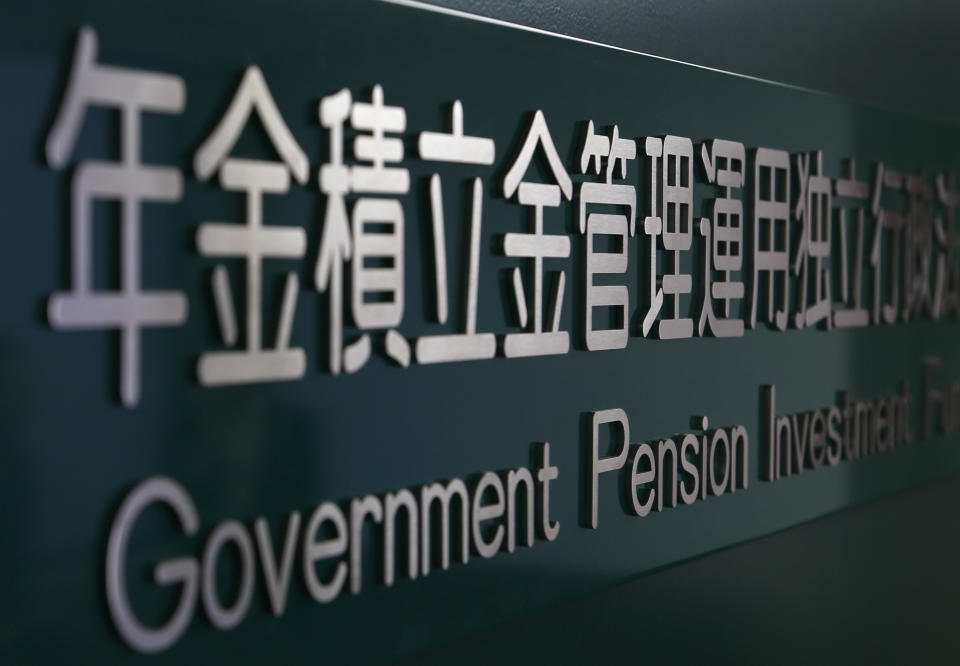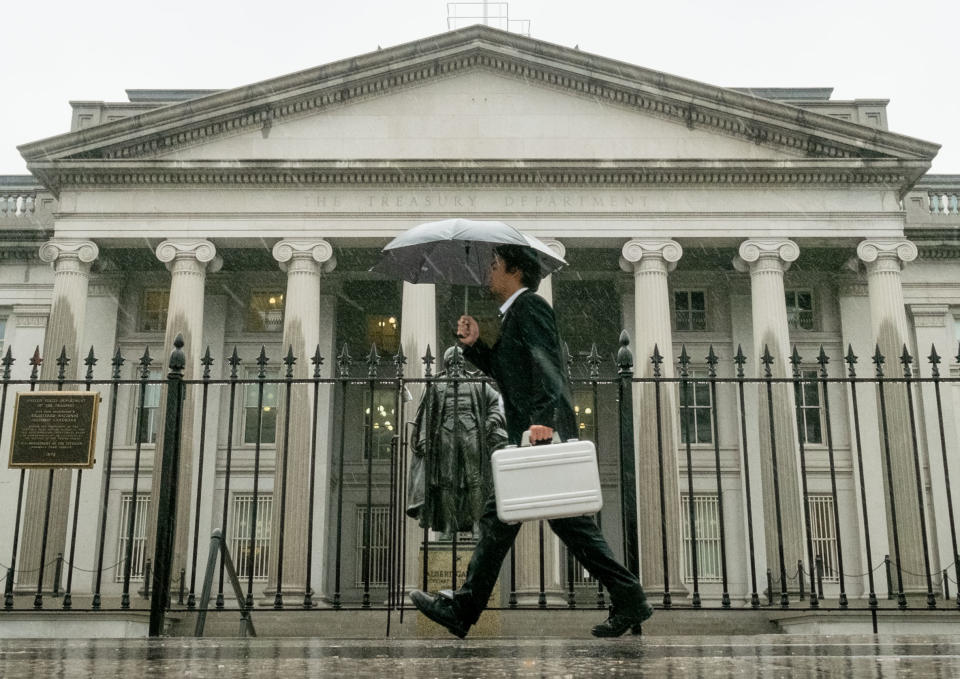Global fears, Uncle Sam's red ink mean investors will feasting on Treasury debt
Just after President Donald Trump signed a sweeping budget bill that suspends the debt ceiling for two years, the Congressional Budget Office projected the ballooning budget deficit will hit $1 trillion in 2020 — adding nearly $2 trillion to the national debt.
In short, Uncle Sam will keep spending more than he takes in for the foreseeable future. All of which begs the question of who’ll absorb the massive amounts of debt at a pace necessary to contain the government’s borrowing costs.
The short answer: Americans will.
While it’s common knowledge that foreigners have been big Treasury buyers for years, that effect is waning. The slack is being picked up by U.S investors that manage pension, retirement and insurance funds, which are deeply invested in the bond market.
These institutions are big and growing buyers of Treasuries, which see government paper as a low-risk asset. The federal government’s endless red ink has done nothing to dissuade investors from pushing long-term interest rates to record lows, and inverting the yield curve in the process.
And that effect won’t dissipate anytime soon. With markets riveted in August by growing fears surrounding the U.S.China trade war, global funds cut their exposure to stocks to their lowest in nearly 3 years while stocking up on government debt, according to a Reuters asset allocation poll of nearly 40 wealth managers in Europe, the U.S., Britain and Japan.
The Reuters data encapsulated a trend playing out across domestic retirement portfolios. As stock markets were walloped last year, corporate pension portfolios’ stock allocations fell last to an average of 31%, according to an annual survey by actuarial services firm Millman.
In recent years, global central bank buying of U.S. debt has waned, but a surge in domestic interest has offset that decline. According to Societe Generale, global currency reserves peaked back in 2014 at $12 trillion, and have since fallen.
Enter insurers and pensions. Deutsche Bank chief U.S. economist Torsten Slok recently estimated that the biggest holder of U.S. Treasuries are American pension funds, insurance companies, and a Federal Reserve that’s done trillions in bond-buying via quantitative easing.
Those investors “have generally shifted toward higher allocations of fixed income investments. This trend has surfaced as plan sponsors shifted allocations to de-risk their pension plans over the past decade,” Millman said.

Still the only game in town
The domestic debt binge recalls Japan’s “lost decade,” in which the aftermath of a burst asset bubble scared off foreign investors. In their place arose domestic institutions that consumed Japanese government bonds en masse.
At a staggering 236%, Japan’s debt to gross domestic product ratio is more than double the U.S., and Tokyo is hard-pressed to engineer sustainable growth. Still the economy has remained stable, and the yen is a popular reserve currency that’s considered one of the world’s strongest safe-havens.
So are the U.S. dollar and Treasuries, which have for decades dodged the twin bullets of a massive U.S. trade and budget imbalance.
“Treasuries are still considered a safe-haven asset,” said Eric Stein, co-director of Global Income for Eaton Vance Management, which has around $440 billion in assets under management. “No market is as deep as the Treasury market.”
In the aftermath of the 2008 crisis, when the Fed went on a massive bond-buying spree, some market watchers predicted holding Treasuries would be a lot less attractive and yields would soar.
Yet the doomsday scenario of surging rates never materialized, even as major economies like China and Japan bought fewer U.S. government bonds.
The vast sea of red ink hasn’t scared U.S. bond investors, underscoring how the bond vigilantes of the past have lost their influence as enforcers of fiscal discipline.
Voracious domestic demand has largely tamed U.S. yields. Recently, the rate on the 10-year Treasury note has tumbled to historic lows below 2%, amid fears of an intensifying U.S.-China trade war. It means pension funds would be vulnerable to a sudden surge in yields.
“Will it last forever? No, but will it end anytime soon? Probably not,” Stein added.
‘We’re not Japan’

For decades, official foreign demand for American assets has funded the current account deficit that’s at the core of the U.S.’s trade war with China.
Economists have long warned the dynamic was unsustainable with an exploding federal deficit, but countries like Japan and China built massive reserves, of over $1 trillion apiece, with dollar-denominated debt.
“If you’re running a current account deficit, that deficit is going to be financed either by borrowing from the rest of the world by selling bonds ... or equity inflows,” explained Brad Setser, a senior fellow at the Council on Foreign Relations.
“Even though the composition of U.S. financing has changed, it is still the case that the U.S. is running a current account deficit,” Setser added.
“Right now the deficit is financed by banks, funds, and odd host of institutional investors. But we’re not Japan,” he said — which has far less international capital but a far higher domestic savings rate.
Foreign inflows into longer-term U.S. debt turned positive in April for the first time this year, Goldman Sachs noted recently — but there was a catch: Global investors are increasingly parking their money in agency securities and high-grade corporate bonds.
Until very recently, foreign officials have been net sellers of long-term U.S. Treasuries, according to the Treasury’s latest International Capital (TIC) data. In the first quarter alone, both China and Japan sold off a combined $18 billion in Treasury debt, yet interest rates kept plunging.
Amid fears that China might “weaponize” its Treasury holdings, Beijing has yet to do so, noted Seema Shah, chief strategist at Principal Global Investors.
“What do they shift to? A lot of people want to sell U.S. debt but until there’s an alternative” there’s nowhere for them to go, she told Yahoo Finance recently.
“Given the aging U.S. population, demand will continue until there’s a tipping point,” Shah added. “We’ve been saying that for years about Japan, and it hasn’t materialized. This could go on and on.”
Trillions at stake

There’s at least $6 trillion parked in various public pension funds, according to an analysis by State Street Global Advisors. The bulk of that allocation is in equities, with 8% is in government bonds.
That asset allocation matters, because pensions are shifting into what they perceive to be a liquid, low-risk asset. But should the U.S. government’s luck runs out with investors, retirement accounts — which themselves are facing massive unfunded liabilities — may find themselves on the hook as government borrowing costs surge.
The idea of institutional investors pulling back from government bonds isn’t entirely unthinkable. Investment giant Pimco — which has over $1.7 trillion in assets under management — raised eyebrows back in 2011, when its former bond guru Bill Gross famously dumped government debt from its Total Return Fund.
At the time, the benchmark 10-year Treasury note yielded well above 3% as investors feared a coming calamity related to the widening budget deficit.
Fast forward nearly a decade, and yields are far lower. Meanwhile, Pimco’s flagship fund holds $66 billion in assets — 66% of which is U.S. government related paper — while its long-term bond fund holds under $1 billion.
The Treasury market is “very much an overcrowded trade that's vulnerable to a backup" in yields, said Candice Bangsund, vice president and portfolio manager at Fiera Capital, a global asset manager with more than $108B in assets.
Fiera is "negative" on government bonds while being overweight equities, Bangsund said. Yet regardless of the risks, Treasuries “are still a safe haven for investors in times of global uncertainty, she added.
Javier David is an editor for Yahoo Finance. Follow Javier on Twitter: @TeflonGeek
Read more:
‘They should really be ashamed:’ Wall Street blasts Fed for getting what it wanted
Investors aren't sweating US's massive corporate debt pile, but maybe they should
Nagging weaknesses underlie the better-than-expected jobs report
No tariff waiver for Mac Pro, Trump tells Apple: 'Make them in the USA!'
Read the latest financial and business news from Yahoo Finance
Follow Yahoo Finance on Twitter, Facebook, Instagram, Flipboard, SmartNews, LinkedIn, YouTube, and reddit.

 Yahoo Finance
Yahoo Finance 
